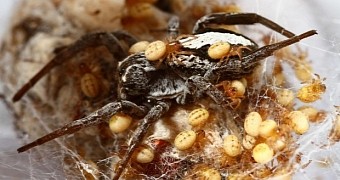A recent paper authored by researcher Mor Salomon at the Israel Cohen Institute for Biological Control and published in the Journal of Arachnology details the breeding behavior of a spider species dubbed Stegodyphus lineatus.
This species populates semi-arid regions in the Mediterranean basin and in Asia. As gruesome as this might sound, it looks like all Stegodyphus lineatus babies start their life as cannibals. Their first victim: their own mother.
Writing in the Journal of Arachnology, specialist Mor Salomon and colleagues explain how, shortly after the young spiders emerge from their eggs, their mother lets them crawl inside her and devour her guts. She never even tries to curb their appetite.
“In the spider Stegodyphus lineatus Latreille 1817 (Eresidae), maternal care is extreme and irreversible: mothers regurgitate food for the young and then die when consumed by them (matriphagy),” the wildlife researchers say.
The spider mom dies a most awful death
Mind you, these cannibal baby spiders don't just barbecue their mom and eat her limbs with mustard. The entire affair would be less shocking and disturbing if they did.
As explained by scientist Mor Salomon, the young spiders grow in a carefully woven nursery. Shorty after they emerge from their eggs, their mother sets them free, and for about two weeks, it feeds them a transparent liquid that she regurgitates.
The recipe for this transparent liquid includes the remains of the spider mom's last meals and part of her own guts. Eventually, the baby spiders grow sick and tired of having to sit around waiting for their next snack and crawl inside their mother.
Once in her abdomen, they gorge themselves on her liquefied intestines. By the time the youngsters are ready to explore the world, their mom is just a shell of her former self. Needless to say, she dies shortly after her babies leaver her.
“She makes to attempt to escape,” says specialist Mor Salomon, as cited by Society for Science. “[The] female invests all of her resources into a single reproductive event,” the wildlife researcher and colleagues further explain.

 14 DAY TRIAL //
14 DAY TRIAL //